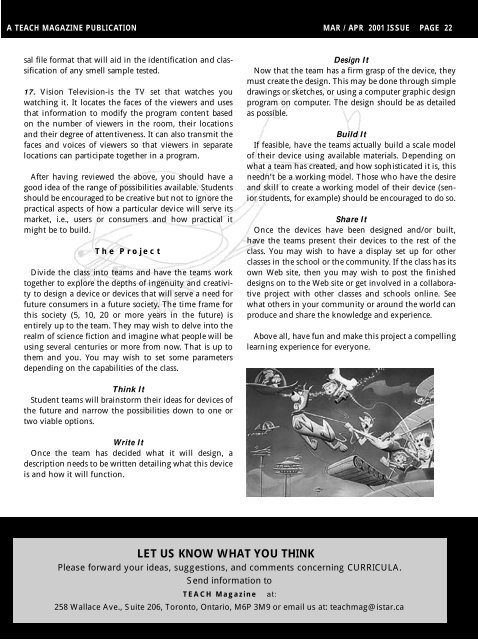Le Prof Le Prof - TEACH Magazine
Le Prof Le Prof - TEACH Magazine
Le Prof Le Prof - TEACH Magazine
You also want an ePaper? Increase the reach of your titles
YUMPU automatically turns print PDFs into web optimized ePapers that Google loves.
A <strong>TEACH</strong> MAGAZINE PUBLICAT I O N MAR / APR 2001 ISSUE PAGE 2 2<br />
sal file format that will aid in the identification and classification<br />
of any smell sample tested.<br />
1 7 . Vision Television-is the TV set that watches you<br />
watching it. It locates the faces of the viewers and uses<br />
that information to modify the program content based<br />
on the number of viewers in the room, their locations<br />
and their degree of attentiveness. It can also transmit the<br />
faces and voices of viewers so that viewers in separate<br />
locations can participate together in a program.<br />
After having reviewed the above, you should have a<br />
good idea of the range of possibilities available. Students<br />
should be encouraged to be creative but not to ignore the<br />
practical aspects of how a particular device will serve its<br />
market, i.e., users or consumers and how practical it<br />
might be to build.<br />
The Project<br />
Divide the class into teams and have the teams work<br />
together to explore the depths of ingenuity and creativity<br />
to design a device or devices that will serve a need for<br />
future consumers in a future society. The time frame for<br />
this society (5, 10, 20 or more years in the future) is<br />
entirely up to the team. They may wish to delve into the<br />
realm of science fiction and imagine what people will be<br />
using several centuries or more from now. That is up to<br />
them and you. You may wish to set some parameters<br />
depending on the capabilities of the class.<br />
Think It<br />
Student teams will brainstorm their ideas for devices of<br />
the future and narrow the possibilities down to one or<br />
two viable options.<br />
Write It<br />
Once the team has decided what it will design, a<br />
description needs to be written detailing what this device<br />
is and how it will function.<br />
LET US KNOW WHAT YOU THINK<br />
Please forward your ideas, suggestions, and comments concerning CURRICULA.<br />
Send information to<br />
TE A C H <strong>Magazine</strong> a t :<br />
Design It<br />
Now that the team has a firm grasp of the device, they<br />
must create the design. This may be done through simple<br />
drawings or sketches, or using a computer graphic design<br />
program on computer. The design should be as detailed<br />
as possible.<br />
Build It<br />
If feasible, have the teams actually build a scale model<br />
of their device using available materials. Depending on<br />
what a team has created, and how sophisticated it is, this<br />
n e e d n ’t be a working model. Those who have the desire<br />
and skill to create a working model of their device (senior<br />
students, for example) should be encouraged to do so.<br />
Share It<br />
Once the devices have been designed and/or built,<br />
have the teams present their devices to the rest of the<br />
class. You may wish to have a display set up for other<br />
classes in the school or the community. If the class has its<br />
own Web site, then you may wish to post the finished<br />
designs on to the Web site or get involved in a collaborative<br />
project with other classes and schools online. See<br />
what others in your community or around the world can<br />
produce and share the knowledge and experience.<br />
Above all, have fun and make this project a compelling<br />
learning experience for every o n e .<br />
258 Wallace Ave., Suite 206, Toronto, Ontario, M6P 3M9 or email us at: teachmag@istar.ca



